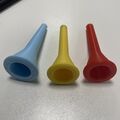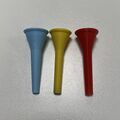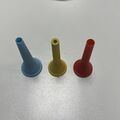FrenchHornMouthpieces: Difference between revisions
mNo edit summary |
Updated to reflect progress and include gallery of various prototypes |
||
| (7 intermediate revisions by the same user not shown) | |||
| Line 1: | Line 1: | ||
{{Project | {{Project | ||
|Name=French Horn Mouthpieces | |Name=French Horn Mouthpieces | ||
|Omschrijving=3D-printing my own mouthpieces | |||
|Status=In progress | |Status=In progress | ||
|Picture=French Horn mouthpieces - metal and 3d-printed.jpg | |Picture=French Horn mouthpieces - metal and 3d-printed.jpg | ||
|Contact= | |Contact=Oops | ||
|LastUpdated=2025- | |LastUpdated=2025-05-14 | ||
}} | }} | ||
| Line 15: | Line 16: | ||
Jane Kass has already created [https://www.thingiverse.com/thing:6002807 STL models of French Horn mouthpieces]. I've tried printing one and now need to figure out how to edit it to make it into something which fits my French Horn. | Jane Kass has already created [https://www.thingiverse.com/thing:6002807 STL models of French Horn mouthpieces]. I've tried printing one and now need to figure out how to edit it to make it into something which fits my French Horn. | ||
== Progress == | |||
I measured the printed mouthpiece from the original STL, the existing mouthpieces, and the French Horn lead pipe. Most of these measurements are now below. | |||
I tried cutting the existing print down, partially for curiosity about what the barrel would be looking like. Having compared the measurements with the thickness of the PLA print am experimenting with a minimal-thickness barrel in my plastic mouthpiece. I worry a bit that the pressure of pressing on the mouthpiece as I play may distort or shave off layers of plastic as it is forced into the lead pipe. | |||
I tried editing the STL (initially in Blender, now in FreeCAD) to taper the barrel of the mouthpiece. It was possible to use the STL model to give me an initial sense of the appropriate scale. | |||
I was able to taper the thin end of the mouthpiece so it fits in the horn and it works to make music. I am experimenting with ironing the top level of the mouthpiece to have a smooth level - which also requires making the top of the mouthpiece flat. | |||
== Process and Progress == | |||
Each time I printed I tended to use a different colour of PLA. In the gallery below the mouthpieces are arranged left to right (blue, yellow, red): | |||
* the blue mouthpiece shows that I had not figured out how to get a smooth rim; | |||
* the yellow mouthpiece shows a smoother rim and better form but the bore was still too thick to use as a mouthpiece - it fits into the horn but is too narrow to use for making music; | |||
* the red mouthpiece is almost the last one done, with a good profile, smooth rim, but the bore is now perhaps too thin. | |||
I reused the red mouthpiece in making the [[WaterBuffaloVuvuzela|Water Buffalo Vuvuzela]]. It makes a permanent part of that instrument and it successfully makes a lot of noise. It is quite forgiving, such that it works for a young child who doesn't otherwise play any brass instruments. | |||
<gallery> | |||
File:3d printed French Horn mouthpieces rims.jpg | |||
File:3d printed French Horn mouthpieces external profiles.jpg | |||
File:3d printed French Horn mouthpieces bores.jpg | |||
</gallery> | |||
Ironing has smoothed out the rim of the printed mouthpiece. I now need to work to thin the walls of the stem - the interior diameter of the bore should be around 6.1mm and currently the walls of the stem are too thick making the bore much narrower. | |||
== Next Steps == | == Next Steps == | ||
I've not (August 2025) worked on this for a month or two. I succeeded in making a mouthpiece which appears to work. | |||
I want to clean up the files so that they could be shared (as STL and likely also as FreeCAD) and figure out how/where to make these available for others to use or tinker with. | |||
I | I may work to adjust these models so that I can make a mouthpiece which could make it easier for me to player lower notes. | ||
== Measurements == | |||
These measurements are based on my horn (Yamaha 664) and existing mouthpieces. If there are two numbers, it reflects a difference between the mouthpieces. | |||
{| | |||
|- | |||
| Mouthpiece length || 64.6, 66.8 mm | |||
|- | |||
| Mouthpiece rim exterior diameter || 25.5 mm | |||
|- | |||
|Exterior diameter bore || 7.6 mm | |||
|- | |||
|Interior diameter bore || 6.1 mm | |||
|- | |||
| Leadpipe interior diameter || 8.00 mm | |||
|- | |||
| Mouthpiece outside lead pipe || 48.3, 52.8 mm | |||
|- | |||
| STL model || | |||
|- | |||
| Mouthpiece rim exterior diameter || 25.6 mm | |||
|- | |||
|Exterior diameter bore || 9.3 mm | |||
|- | |||
| Mouthpiece length || 94 mm (approximately) | |||
|} | |||
Latest revision as of 11:21, 9 August 2025
| Project French Horn Mouthpieces | |
|---|---|

| |
| 3D-printing my own mouthpieces | |
| Status | In progress |
| Contact | Oops |
| Last Update | 2025-08-09 |
Introduction
I am wanting to experiment a bit with 3D printing and want a somewhat "real" project. I play French Horn (in Bataafs Symfonieorkest) and have two metal mouthpieces which I use, one of them my "regular" mouthpiece, the other which I use less frequently which is not so good for high range notes.
Resources
Jane Kass has already created STL models of French Horn mouthpieces. I've tried printing one and now need to figure out how to edit it to make it into something which fits my French Horn.
Progress
I measured the printed mouthpiece from the original STL, the existing mouthpieces, and the French Horn lead pipe. Most of these measurements are now below.
I tried cutting the existing print down, partially for curiosity about what the barrel would be looking like. Having compared the measurements with the thickness of the PLA print am experimenting with a minimal-thickness barrel in my plastic mouthpiece. I worry a bit that the pressure of pressing on the mouthpiece as I play may distort or shave off layers of plastic as it is forced into the lead pipe.
I tried editing the STL (initially in Blender, now in FreeCAD) to taper the barrel of the mouthpiece. It was possible to use the STL model to give me an initial sense of the appropriate scale.
I was able to taper the thin end of the mouthpiece so it fits in the horn and it works to make music. I am experimenting with ironing the top level of the mouthpiece to have a smooth level - which also requires making the top of the mouthpiece flat.
Process and Progress
Each time I printed I tended to use a different colour of PLA. In the gallery below the mouthpieces are arranged left to right (blue, yellow, red):
- the blue mouthpiece shows that I had not figured out how to get a smooth rim;
- the yellow mouthpiece shows a smoother rim and better form but the bore was still too thick to use as a mouthpiece - it fits into the horn but is too narrow to use for making music;
- the red mouthpiece is almost the last one done, with a good profile, smooth rim, but the bore is now perhaps too thin.
I reused the red mouthpiece in making the Water Buffalo Vuvuzela. It makes a permanent part of that instrument and it successfully makes a lot of noise. It is quite forgiving, such that it works for a young child who doesn't otherwise play any brass instruments.
Ironing has smoothed out the rim of the printed mouthpiece. I now need to work to thin the walls of the stem - the interior diameter of the bore should be around 6.1mm and currently the walls of the stem are too thick making the bore much narrower.
Next Steps
I've not (August 2025) worked on this for a month or two. I succeeded in making a mouthpiece which appears to work.
I want to clean up the files so that they could be shared (as STL and likely also as FreeCAD) and figure out how/where to make these available for others to use or tinker with.
I may work to adjust these models so that I can make a mouthpiece which could make it easier for me to player lower notes.
Measurements
These measurements are based on my horn (Yamaha 664) and existing mouthpieces. If there are two numbers, it reflects a difference between the mouthpieces.
| Mouthpiece length | 64.6, 66.8 mm |
| Mouthpiece rim exterior diameter | 25.5 mm |
| Exterior diameter bore | 7.6 mm |
| Interior diameter bore | 6.1 mm |
| Leadpipe interior diameter | 8.00 mm |
| Mouthpiece outside lead pipe | 48.3, 52.8 mm |
| STL model | |
| Mouthpiece rim exterior diameter | 25.6 mm |
| Exterior diameter bore | 9.3 mm |
| Mouthpiece length | 94 mm (approximately) |


